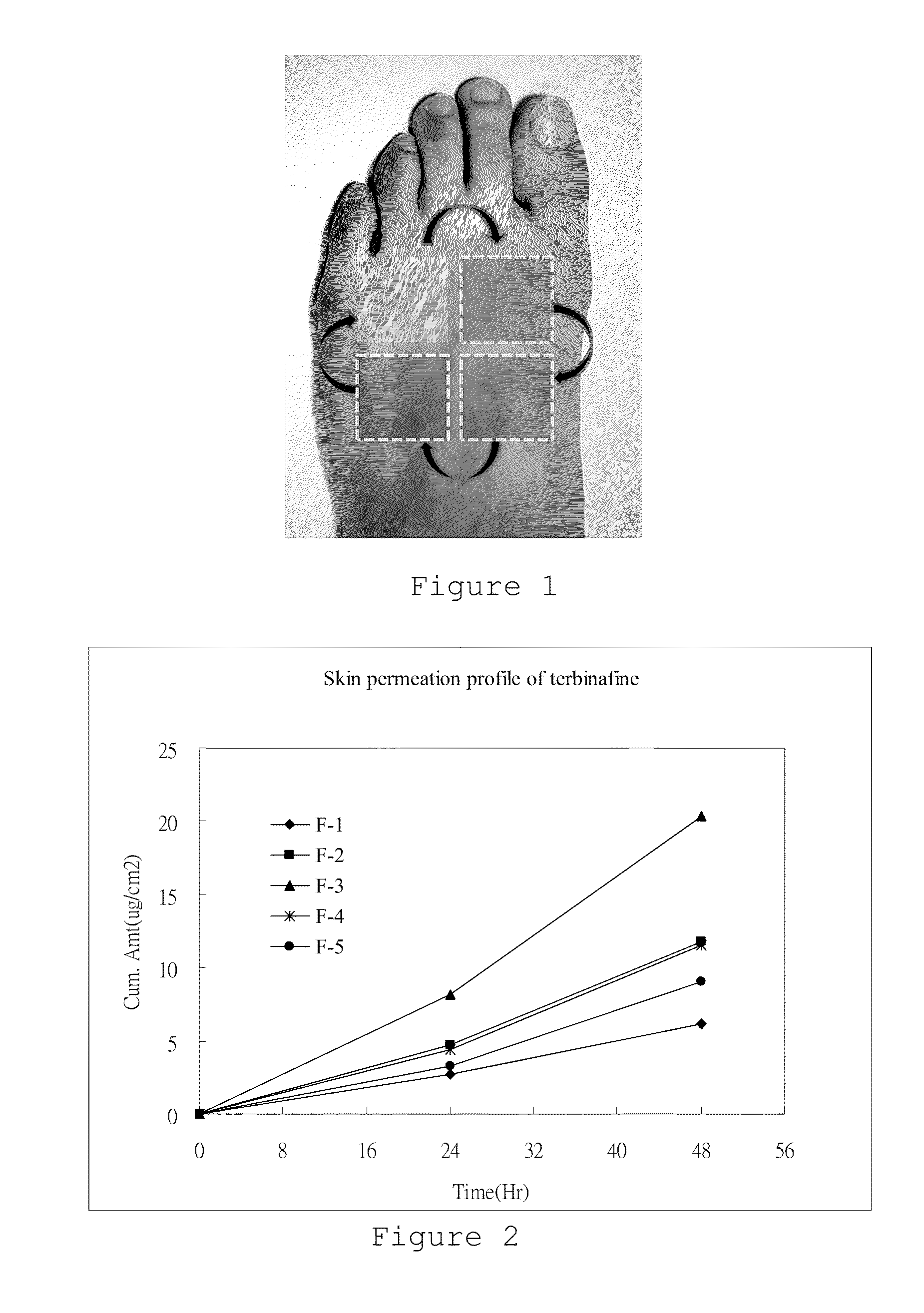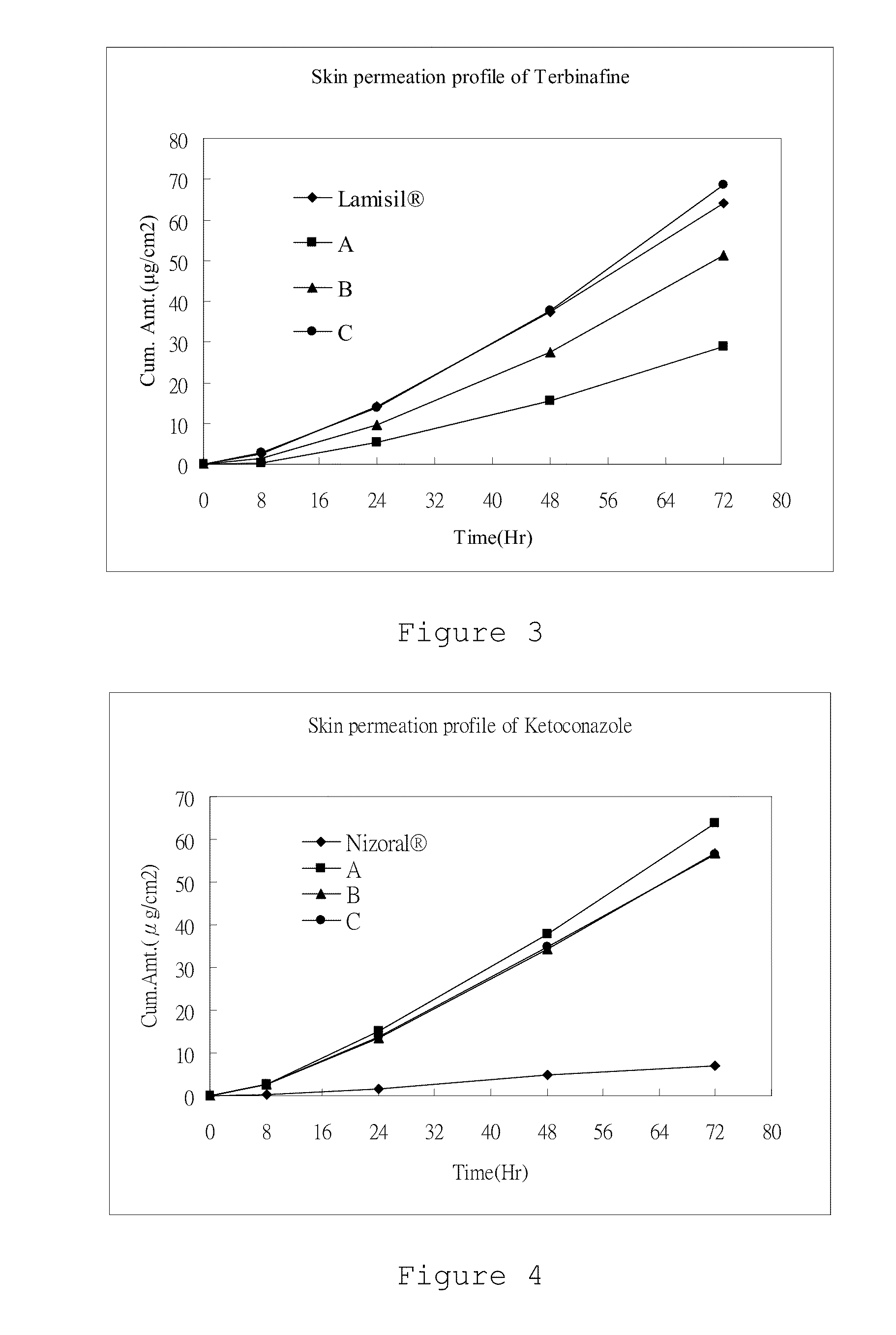Pressure sensitive adhesive matrix device or system for the treatment or prevention of onychomycosis or tinea pedis
- Summary
- Abstract
- Description
- Claims
- Application Information
AI Technical Summary
Benefits of technology
Problems solved by technology
Method used
Image
Examples
example 1
Preparation of the Pressure-Sensitive Adhesive Matrix Patch Device of the Invention
[0050]A pressure-sensitive adhesive matrix patch device comprising the compositions shown in Tables 1 and 2 below contained in a matrix layer was produced. Specifically, terbinafine, ketoconazole, and an enhancer listed in Tables 1 and 2 were well mixed. Then, the mixture was mixed with an adhesive dissolved in ethyl acetate. A release liner was coated with the solution, followed by removal of the ethyl acetate by drying. The laminate and a backing layer were bonded together to obtain the pressure-sensitive adhesive matrix patch device.
TABLE 1F-1F-2F-3F-4F-5(wt %)(wt %)(wt %)(wt %)(wt %)terbinafine2.52.52.52.52.5Duro-tak ® 205289.589.589.589.589.5triacetin8N-methyl-pyrrolidone8lauryl lactate8propylene glycol8monolauratediethyleneglycol8monoethyl etherethyl acetateq.s.q.s.q.s.q.s.q.s.q.s.: sufficient amounts
TABLE 2A (wt %)B (wt %)C (wt %)terbinafine368ketoconazole222Gelva ® 737878482lauryl888lactateeth...
example 2
Skin Flux Methodology
[0051]1. Samples
[0052](1) Examples F-1, F-2, F-3, F-4, and F-5: 2.5 mg terbinafine / 10 cm2 patch
[0053](2) Lamisil cream (NOVARTIS®): 10 mg of terbinafine / g of cream (1%)
[0054](3) Nizoral cream (JANSSEN-CILAG®): 20 mg of ketoconazole / g of cream (2%)
[0055](4) Example A: 3 mg of terbinafine and 2 mg of ketoconazole / 10 cm2 patch
[0056](5) Example B: 6 mg of terbinafine and 2 mg of ketoconazole / 10 cm2 patch
[0057](6) Example C: 8 mg of terbinafine and 2 mg of ketoconazole / 10 cm2 patch
[0058]2. Testing Method and Steps
[0059](1) Skin penetration device
[0060]Skin was cut into a predetermined area of several pieces, i.e., a width of about 10 mm and a length of about 42 mm. The skin pieces were immersed in water at 60° C. for about 75 sec. Then, the subcutaneous tissue and stratum corneum of the skin pieces were separated by a tweezer, and the stratum corneum was cut into a predetermined area of several pieces, i.e., 1 cm2. The stratum corneum pieces were positioned at a side...
PUM
| Property | Measurement | Unit |
|---|---|---|
| Fraction | aaaaa | aaaaa |
| Fraction | aaaaa | aaaaa |
| Fraction | aaaaa | aaaaa |
Abstract
Description
Claims
Application Information
 Login to View More
Login to View More - Generate Ideas
- Intellectual Property
- Life Sciences
- Materials
- Tech Scout
- Unparalleled Data Quality
- Higher Quality Content
- 60% Fewer Hallucinations
Browse by: Latest US Patents, China's latest patents, Technical Efficacy Thesaurus, Application Domain, Technology Topic, Popular Technical Reports.
© 2025 PatSnap. All rights reserved.Legal|Privacy policy|Modern Slavery Act Transparency Statement|Sitemap|About US| Contact US: help@patsnap.com


